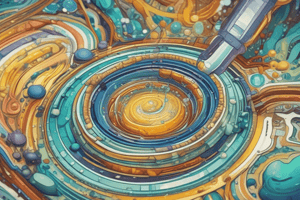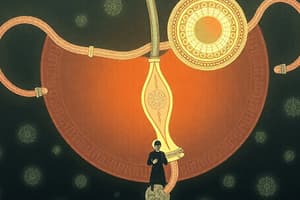Podcast
Questions and Answers
What is the normal range for urine specific gravity (SG) in most domestic species?
What is the normal range for urine specific gravity (SG) in most domestic species?
- 1.015 - 1.045 (correct)
- 0.990 - 1.020
- 1.008 - 1.012
- 1.050 - 1.070
Which of the following conditions is NOT associated with increased urine specific gravity (SG)?
Which of the following conditions is NOT associated with increased urine specific gravity (SG)?
- Increased urine solutes
- Dehydration
- Renal failure (correct)
- Diabetes mellitus
What is the condition called when urine SG is similar to plasma and is not more concentrated or diluted?
What is the condition called when urine SG is similar to plasma and is not more concentrated or diluted?
- Hyperstenuria
- Isosthenuria (correct)
- Hypostenuria
- Oliguria
Which of the following factors can contribute to an ammonia odor in fresh urine?
Which of the following factors can contribute to an ammonia odor in fresh urine?
What can cause a sweet and fruity odor in urine?
What can cause a sweet and fruity odor in urine?
Which of the following is NOT a formed element that can cause lack of transparency in urine?
Which of the following is NOT a formed element that can cause lack of transparency in urine?
What does the presence of excessive foam that is slow to dissipate in urine suggest?
What does the presence of excessive foam that is slow to dissipate in urine suggest?
Which of the following methods for determining urine specific gravity is the most accurate?
Which of the following methods for determining urine specific gravity is the most accurate?
What is the term for a decrease in urine volume?
What is the term for a decrease in urine volume?
Which of the following is considered a physiological cause of polyuria?
Which of the following is considered a physiological cause of polyuria?
Which of the following is NOT a factor influencing urine volume?
Which of the following is NOT a factor influencing urine volume?
What is the relationship between urine volume and specific gravity?
What is the relationship between urine volume and specific gravity?
What is the difference between polyuria and pollakiuria?
What is the difference between polyuria and pollakiuria?
Which condition is characterized by the pancreas not producing insulin?
Which condition is characterized by the pancreas not producing insulin?
Which of the following is NOT a potential cause of polyuria?
Which of the following is NOT a potential cause of polyuria?
Which of these substances is NOT involved in regulating urine volume?
Which of these substances is NOT involved in regulating urine volume?
Which type of crystal is commonly associated with Feline Lower Urinary Tract Disease (FLUTD) in cats?
Which type of crystal is commonly associated with Feline Lower Urinary Tract Disease (FLUTD) in cats?
Which crystal type is commonly found in herbivores, contributing to the cloudy appearance of their urine?
Which crystal type is commonly found in herbivores, contributing to the cloudy appearance of their urine?
What crystal type is associated with a potential issue in liver function when found in felines, equines, bovines, and camelids?
What crystal type is associated with a potential issue in liver function when found in felines, equines, bovines, and camelids?
Which crystal type is commonly observed in Dalmatians due to their inability to convert uric acid to allantoin?
Which crystal type is commonly observed in Dalmatians due to their inability to convert uric acid to allantoin?
Which crystal type can be associated with ethylene glycol toxicity (antifreeze) and may exhibit a "picket fence" formation?
Which crystal type can be associated with ethylene glycol toxicity (antifreeze) and may exhibit a "picket fence" formation?
Which crystal type is commonly found in acidic urine and can be a sign of disorders of protein metabolism in dogs?
Which crystal type is commonly found in acidic urine and can be a sign of disorders of protein metabolism in dogs?
Which crystal type is commonly associated with liver disease in humans but is less common in dogs and cats?
Which crystal type is commonly associated with liver disease in humans but is less common in dogs and cats?
Which of these crystals are typically found in alkaline urine? (Select all that apply)
Which of these crystals are typically found in alkaline urine? (Select all that apply)
What conditions can cause a decreased pH (acidic) in urine?
What conditions can cause a decreased pH (acidic) in urine?
What is the normal urine pH range for a horse?
What is the normal urine pH range for a horse?
Which of the following is NOT a cause of physiological proteinuria?
Which of the following is NOT a cause of physiological proteinuria?
What is the significance of interpreting proteinuria in conjunction with urine specific gravity (SG)?
What is the significance of interpreting proteinuria in conjunction with urine specific gravity (SG)?
What type of proteinuria occurs due to increased permeability of the glomerulus or impaired reabsorption of protein by the renal tubules?
What type of proteinuria occurs due to increased permeability of the glomerulus or impaired reabsorption of protein by the renal tubules?
What is the main reason for a false-positive glucose test on a reagent strip?
What is the main reason for a false-positive glucose test on a reagent strip?
What is the approximate renal threshold for glucose in cats?
What is the approximate renal threshold for glucose in cats?
Which of the following conditions can cause pathologic hyperglycemic glucosuria?
Which of the following conditions can cause pathologic hyperglycemic glucosuria?
Which type of proteinuria is most likely to be associated with an inflamed bladder?
Which type of proteinuria is most likely to be associated with an inflamed bladder?
What is the significance of a positive nitrite test in fresh urine?
What is the significance of a positive nitrite test in fresh urine?
What is the most likely cause of proteinuria in a dog with a history of strenuous exercise?
What is the most likely cause of proteinuria in a dog with a history of strenuous exercise?
Which of the following is NOT a factor that influences the presence of glucose in urine?
Which of the following is NOT a factor that influences the presence of glucose in urine?
What is the name of the condition where protein is found in the urine due to excessive muscle damage?
What is the name of the condition where protein is found in the urine due to excessive muscle damage?
Which of the following medications can cause false-positive results on a reagent strip glucose test?
Which of the following medications can cause false-positive results on a reagent strip glucose test?
What factor may cause a very dilute urine to result in a false-negative reading for protein on a reagent strip?
What factor may cause a very dilute urine to result in a false-negative reading for protein on a reagent strip?
In which species is mucus in urine considered normal?
In which species is mucus in urine considered normal?
What is the significance of finding sperm in a urine sample?
What is the significance of finding sperm in a urine sample?
What is the most common site of bacterial infection in the urinary system?
What is the most common site of bacterial infection in the urinary system?
Which of the following urinary system parasites is considered the largest nematode?
Which of the following urinary system parasites is considered the largest nematode?
Which of the following is NOT a possible source of fecal or genital contamination in urine samples?
Which of the following is NOT a possible source of fecal or genital contamination in urine samples?
Which of the following is a characteristic of yeast in urine samples?
Which of the following is a characteristic of yeast in urine samples?
Which of the following statements is TRUE about fungi in urine samples?
Which of the following statements is TRUE about fungi in urine samples?
Which of the following conditions could lead to increased levels of urobilinogen in urine?
Which of the following conditions could lead to increased levels of urobilinogen in urine?
What is the primary function of bilirubin in the body?
What is the primary function of bilirubin in the body?
A urine dipstick test reveals the presence of ketones. What is the most likely reason for this finding?
A urine dipstick test reveals the presence of ketones. What is the most likely reason for this finding?
Which of the following is a common cause of hematuria?
Which of the following is a common cause of hematuria?
Which of the following is NOT a potential cause of hemoglobinuria?
Which of the following is NOT a potential cause of hemoglobinuria?
What is the difference between hematuria and hemoglobinuria?
What is the difference between hematuria and hemoglobinuria?
Why is it important to collect a fresh urine sample for urobilinogen testing?
Why is it important to collect a fresh urine sample for urobilinogen testing?
The presence of ketones in the urine can be indicative of:
The presence of ketones in the urine can be indicative of:
A negative nitrite test does not always rule out the presence of nitrate-reducing bacteria in the urine. Why?
A negative nitrite test does not always rule out the presence of nitrate-reducing bacteria in the urine. Why?
Why is it recommended to use a microscopic examination to determine the presence of bacteria in urine?
Why is it recommended to use a microscopic examination to determine the presence of bacteria in urine?
What is the purpose of collecting a urine sample for microscopic analysis?
What is the purpose of collecting a urine sample for microscopic analysis?
Which of the following best describes the term "occult blood" in urine analysis?
Which of the following best describes the term "occult blood" in urine analysis?
Which of the following conditions can cause myoglobinuria?
Which of the following conditions can cause myoglobinuria?
Which of the following tests can be used to differentiate between hemoglobinuria and myoglobinuria?
Which of the following tests can be used to differentiate between hemoglobinuria and myoglobinuria?
What is the significance of finding a high level of bilirubin in the urine?
What is the significance of finding a high level of bilirubin in the urine?
Why is it important to collect urine samples for analysis within a short timeframe?
Why is it important to collect urine samples for analysis within a short timeframe?
What is the primary function of the kidneys in relation to urine formation?
What is the primary function of the kidneys in relation to urine formation?
Flashcards
Influences on Urine Volume
Influences on Urine Volume
Factors that affect the amount of urine produced, including water intake and activity level.
Specific Gravity (SG)
Specific Gravity (SG)
A measure of urine concentration; low SG indicates dilute urine, high SG indicates concentrated urine.
Polyuria (PU)
Polyuria (PU)
Increased urine volume over a 24-hour period; can be due to physiologic or pathologic causes.
Physiologic Polyuria
Physiologic Polyuria
Signup and view all the flashcards
Pathologic Polyuria
Pathologic Polyuria
Signup and view all the flashcards
Oliguria
Oliguria
Signup and view all the flashcards
Diabetes Mellitus
Diabetes Mellitus
Signup and view all the flashcards
Diabetes Insipidus
Diabetes Insipidus
Signup and view all the flashcards
Cloudy Urine
Cloudy Urine
Signup and view all the flashcards
Strong Odor
Strong Odor
Signup and view all the flashcards
Ammonia Odor
Ammonia Odor
Signup and view all the flashcards
Specific Gravity
Specific Gravity
Signup and view all the flashcards
Isosthenuria
Isosthenuria
Signup and view all the flashcards
Increased Urine SG
Increased Urine SG
Signup and view all the flashcards
Decreased Urine SG
Decreased Urine SG
Signup and view all the flashcards
Proteinuria
Proteinuria
Signup and view all the flashcards
Crystalluria
Crystalluria
Signup and view all the flashcards
Struvite Crystals
Struvite Crystals
Signup and view all the flashcards
Amorphous Phosphates
Amorphous Phosphates
Signup and view all the flashcards
Calcium Oxalate Dihydrate
Calcium Oxalate Dihydrate
Signup and view all the flashcards
Uric Acid
Uric Acid
Signup and view all the flashcards
Cystine Crystals
Cystine Crystals
Signup and view all the flashcards
Ammonium Urates
Ammonium Urates
Signup and view all the flashcards
Bilirubin in Urine
Bilirubin in Urine
Signup and view all the flashcards
Reagent Strips
Reagent Strips
Signup and view all the flashcards
pH in Urine
pH in Urine
Signup and view all the flashcards
Normal Urine pH for Dogs and Cats
Normal Urine pH for Dogs and Cats
Signup and view all the flashcards
Physiologic Proteinuria
Physiologic Proteinuria
Signup and view all the flashcards
Pathologic Proteinuria
Pathologic Proteinuria
Signup and view all the flashcards
Glucosuria
Glucosuria
Signup and view all the flashcards
Renal Threshold for Glucose
Renal Threshold for Glucose
Signup and view all the flashcards
Physiologic Hyperglycemic Glucosuria
Physiologic Hyperglycemic Glucosuria
Signup and view all the flashcards
Pathologic Hyperglycemic Glucosuria
Pathologic Hyperglycemic Glucosuria
Signup and view all the flashcards
Non-hyperglycemic Glucosuria
Non-hyperglycemic Glucosuria
Signup and view all the flashcards
Nitrite Test
Nitrite Test
Signup and view all the flashcards
False-Positive Glucosuria
False-Positive Glucosuria
Signup and view all the flashcards
Expiration of Dipsticks
Expiration of Dipsticks
Signup and view all the flashcards
Handling Reagent Strips
Handling Reagent Strips
Signup and view all the flashcards
Mucus in Urine
Mucus in Urine
Signup and view all the flashcards
Sperm in Urine
Sperm in Urine
Signup and view all the flashcards
Lipuria (Fat in Urine)
Lipuria (Fat in Urine)
Signup and view all the flashcards
Bacteriuria
Bacteriuria
Signup and view all the flashcards
Yeast in Urine
Yeast in Urine
Signup and view all the flashcards
Fungal Infections
Fungal Infections
Signup and view all the flashcards
Dioctophyma renale
Dioctophyma renale
Signup and view all the flashcards
Tritrichomonas foetus
Tritrichomonas foetus
Signup and view all the flashcards
Nitrate-reducing bacteria
Nitrate-reducing bacteria
Signup and view all the flashcards
Ketonuria
Ketonuria
Signup and view all the flashcards
Causes of Ketonuria
Causes of Ketonuria
Signup and view all the flashcards
Ketoacidosis
Ketoacidosis
Signup and view all the flashcards
Bilirubinuria
Bilirubinuria
Signup and view all the flashcards
Prehepatic causes for Bilirubinuria
Prehepatic causes for Bilirubinuria
Signup and view all the flashcards
Hepatic causes for Bilirubinuria
Hepatic causes for Bilirubinuria
Signup and view all the flashcards
Posthepatic causes for Bilirubinuria
Posthepatic causes for Bilirubinuria
Signup and view all the flashcards
Urobilinogen
Urobilinogen
Signup and view all the flashcards
Fresh urine sample for Urobilinogen
Fresh urine sample for Urobilinogen
Signup and view all the flashcards
Hematuria
Hematuria
Signup and view all the flashcards
Causes of Hematuria
Causes of Hematuria
Signup and view all the flashcards
Hemoglobinuria
Hemoglobinuria
Signup and view all the flashcards
Myoglobinuria
Myoglobinuria
Signup and view all the flashcards
Differentiating Myoglobinuria from Hemoglobinuria
Differentiating Myoglobinuria from Hemoglobinuria
Signup and view all the flashcards
Study Notes
General Urinalysis Information
- Urinalysis aids in diagnosing conditions like diabetes, UTIs, and chronic renal failure.
- It can be used to screen for diseases and monitor disease progression.
- Urinalysis helps evaluate therapy, such as insulin treatment for diabetes.
Components of a Urinalysis
- Gross Exam: Includes color, clarity, volume, and odor of the urine sample.
- Chemical Analysis: Evaluates dissolved substances in the urine sample.
- Microscopic Exam: Assesses formed elements within the urine sample.
Taking a History
- Obtaining a client history is crucial for accurate interpretation of the urinalysis.
- Questions should be non-leading and specific, focusing on changes in water consumption, urine output, bladder habits, and gross appearance of the urine.
Urine Collection Methods
- Refer to Week 1 lab notes for details on urine collection methods.
Urinalysis – The Gross Exam
- Volume: Normal urine production for a normotensive, normovolemic patient with intact renal function is typically 1-2 ml/kg/hour.
- An example is a 62-pound dog producing 675-1350 ml in 24 hours.
- Closed systems can monitor volume via urinary catheters, but metabolic cages are often easier to use and are readily available at most clinics.
- Factors influencing urine volume include water intake, environmental temperature, food intake, level of physical activity, and species of the animal.
Urine Volume & Specific Gravity (SG)
- High volume urine usually has a low specific gravity (dilute).
- Low volume urine typically has a high specific gravity (concentrated).
- Polyuria is an increase in urine volume measured over a 24-hour period. Normal and appropriate polyuria is considered a physiologic response with low specific gravity and pale urine. Conversely, abnormal polyuria is pathological and indicative of disease with frequent urination.
- Polyuria is not the same as pollakiuria, which is frequent urination, but total 24-hour volume is considered normal.
Oliguria
- Oliguria is a decrease in urine volume that can be either physiologic or pathologic. Physiologic oliguria is due to factors like decreased fluid intake or mild dehydration. Pathologic oliguria may result from dehydration, cardiac disease, renal failure, or shock.
Anuria
- Anuria is the complete absence of urine production; this is always considered pathological. Causes include blockage of the urethra or bladder, and end-stage renal failure.
Urine Color
- Normal urine color ranges from pale yellow to amber, a by-product of hemoglobin breakdown.
- Yellowish-brown or greenish-brown urine suggests bile pigments.
- Reddish-brown urine indicates the presence of red blood cells (hematuria).
- Brownish-black urine may indicate myoglobin.
Urine Transparency
- Transparent urine contains less particulate matter, while slightly cloudy urine indicates slightly more particulate matter.
- Turbid or cloudy urine suggests formed elements (e.g., crystals, bacteria, cells, or mucus).
Urine Odor
- Normal urine can vary in strength, but some species and odors are notable.
- Strong odor is common in normal males.
- Ammonia odor suggests bacterial cystitis.
- Sweet or fruity odor suggests ketones.
Urine Foam
- A small amount of white foam is considered normal.
- Excessive foam suggests proteinuria, and/or bilirubinuria.
Studying That Suits You
Use AI to generate personalized quizzes and flashcards to suit your learning preferences.




